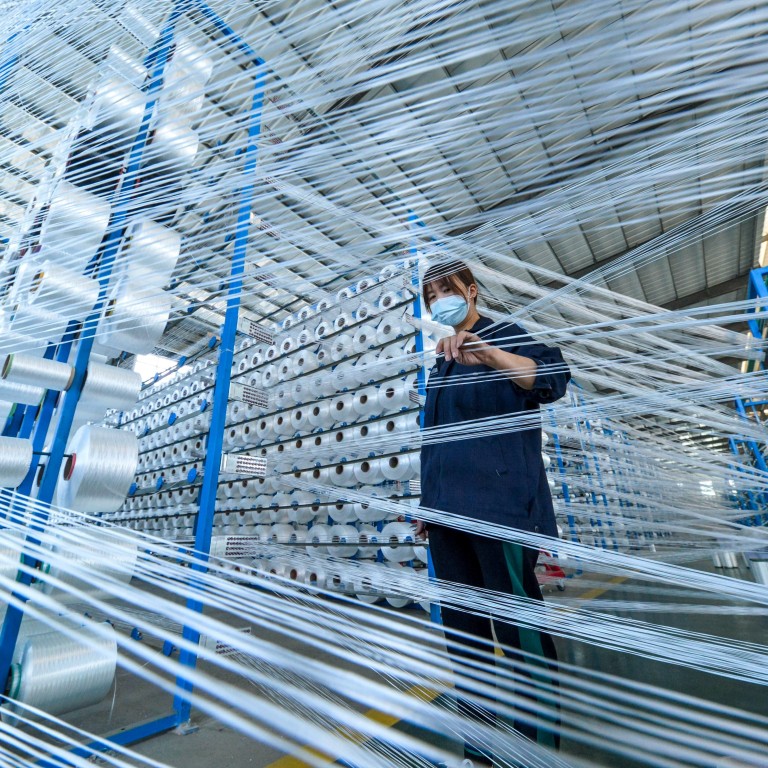
Looking for lingerie? Chinese production lines pick up slack as garment, textile orders shift from India
- Some global brands are turning to China to ensure holiday orders are fulfilled during the pandemic, but expanding future production outside China is still on the cards
- One factory in China’s manufacturing hub of Guangdong received an order for 800,000 sets of underwear – an order that was supposed to go elsewhere
The European Union wants underwear. And China has got it covered.
Upended by the coronavirus pandemic, the global textile and garment supply chain is shifting its focus back to China ahead of the busy year-end period as overseas customers have turned away from India, which is still battling an out-of-control pandemic.
In Zhaoqing city, in China’s manufacturing hub of Guangdong province, an executive at an underwear factory that supplies a high-profile overseas brand said they had no export orders in April or May, resulting in workers being laid off. But in August and last month, as the pandemic continued to spread in Southeast Asia, foreign orders returned.
“We will have an order for 800,000 sets of underwear next month for the EU market,” the executive said on condition of anonymity, as he was not authorised to talk to the media. “We will be very busy next month, and now we are recruiting some workers to fill the order. The brand had not placed orders [with us] for a while.”
According to figures from Johns Hopkins University, India has recorded more than 7.3 million coronavirus infections – second most behind the United States – and 112,000 deaths, which is the third most behind the US and Brazil.
As a backbone of the Indian economy, the textile and apparel industry is its largest source of foreign exchange earnings, accounting for about 15 per cent of its export earnings and 2 per cent of the country’s gross domestic product.
When a lockdown happens, [producers] have to make corrections accordingly, like by downsizing production lines or looking for short-term orders that can be turned around quickly
Gaurav Sharma, a fashion sourcing professional based in Hong Kong, said the lockdown in India has severely affected the delivery of Christmas orders. Normally these orders need to reach buyers in November to be on shelves by December.
“Everyone I know working in the Indian textile and garment industry is in a defensive mode. They understand the problems on two sides. On one side, customers are placing fewer orders. On the other side, they are not sure about productions. When a lockdown happens, they have to make corrections accordingly, like by downsizing production lines or looking for short-term orders that can be turned around quickly.”
With its production capacity having improved from lockdowns earlier this year, China’s textile and garment manufacturing industry has shown promising signs of recovery in the second half of the year.
Thanks largely to strong demand for masks amid the pandemic, monthly year-on-year growth of textile exports has been in the double digits since April. And growth of apparel exports also turned positive in August for the first time since March.
Li Xinggan, director of the Department of Foreign Trade under the Ministry of Commerce, said in a media briefing on Wednesday that without masks, China’s textile exports would have fallen by double digits this year. Li also said that the shift in orders from India to China in recent months was normal market behaviour.
While the returning orders are good news for Chinese manufacturers, most see the trend as a short-term adjustment, and it will not stop buyers from looking for suppliers outside China amid rising geopolitical tensions between Washington and Beijing.
A senior executive with a Taiwan-based manufacturer that has factories in China and India, who asked not to be identified, also said most of their export orders were currently being produced at plants in Guangdong, after production capacity in India was hit by the pandemic.
“This will not affect our plans to continue to expand production capacity out of China,” she said. “The political and epidemic uncertainties are very high for the coming years. It is necessary for every international brand to deploy production capacity in different regions for different markets. We will continue to require our downstream suppliers to set up factories outside of China.”
Lisa Cai, a Chinese garment-exporting manufacturer, said orders have indeed returned in recent months from Bangladesh, Vietnam and India, but most were mainly short-term orders for the coming Christmas and Thanksgiving holiday seasons. She also cited the pandemic’s impact on production capacities in Southeast Asia.
“As soon as the pandemic eases, the factories there can resume production, and orders will still be placed out of China,” Cai said. “After all, Chinese companies no longer have any cost advantages in middle- and low-end apparel manufacturing, let alone tariff preferences.”


